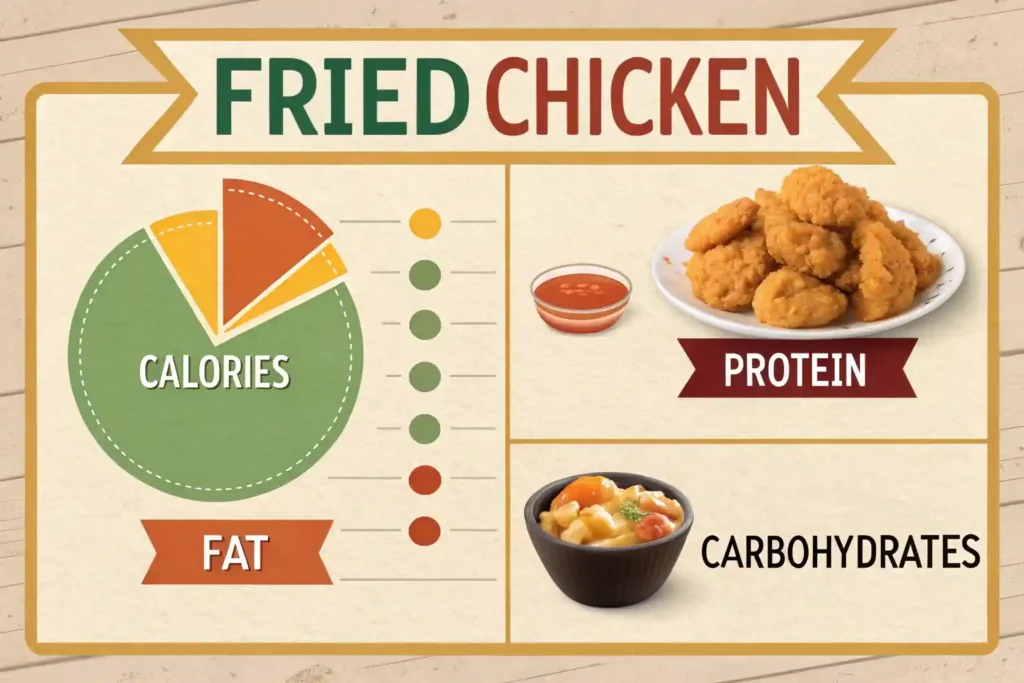Table of contents
1. Understanding Fried Chicken
Fried chicken is a beloved dish enjoyed by many around the world. However, its health implications often spark debate. To understand whether fried chicken is healthy, we need to explore its definition, common cooking methods, and nutritional breakdown.
What is Fried Chicken?
Fried chicken typically consists of chicken pieces that are coated in a seasoned batter and then deep-fried until golden brown. This cooking method creates a crispy exterior while keeping the meat juicy and tender. Variations exist globally, with different spices and cooking techniques influencing the flavor and texture.
Common Cooking Methods
- Deep Frying:
- The traditional method, where chicken is submerged in hot oil.
- Results in a crispy texture but can add significant calories and unhealthy fats.
- Air Frying:
- A healthier alternative that uses hot air circulation to cook the chicken.
- Requires less oil, resulting in lower fat content.
- Baking:
- Involves cooking chicken in the oven, often with a light coating.
- Can produce a healthier version of fried chicken with fewer calories.
Nutritional Breakdown
Understanding the nutritional value of fried chicken is crucial for assessing its healthiness. Here’s a general breakdown per serving (about 3.5 ounces or 100 grams):
- Calories: Approximately 300-400 calories
- Protein: 20-25 grams
- Fat: 15-25 grams (depending on the cooking method)
- Carbohydrates: 10-15 grams

While fried chicken provides a good source of protein, the high fat and calorie content can be concerning, especially when consumed in large quantities.
2. Is Fried Chicken Really Unhealthy?
The question of whether fried chicken is unhealthy is complex and depends on various factors, including cooking methods, portion sizes, and individual dietary needs.
Health Risks Associated with Fried Foods
- High in Unhealthy Fats:
- Deep-fried foods often contain trans fats, which can raise bad cholesterol levels and increase the risk of heart disease.
- Caloric Density:
- Fried chicken is calorie-dense, meaning it provides a high number of calories in a small serving. This can lead to weight gain if consumed frequently.
- Potential for Acrylamide Formation:
- Cooking starchy foods at high temperatures can produce acrylamide, a chemical linked to cancer in animal studies.
Impact of Frying on Nutritional Value
- Loss of Nutrients:
- The frying process can lead to a loss of certain nutrients, particularly if the chicken is overcooked.
- Increased Sodium:
- Many fried chicken recipes call for salt and other seasonings, which can contribute to high sodium intake, leading to hypertension and other health issues.
Comparison with Other Cooking Methods
- Air Frying vs. Deep Frying:
- Air-fried chicken can have up to 70% less fat than deep-fried versions, making it a healthier option.
- Baked Chicken:
- Baking chicken with herbs and spices can enhance flavor without the added calories and fats from frying.
3. Is Fried Chicken Once a Week Healthy?
Moderation is key when it comes to enjoying fried chicken. Eating it once a week can be acceptable for many people, but it’s essential to consider individual health goals and dietary needs.
Frequency of Consumption and Health Implications
- Balanced Diet:
- Incorporating fried chicken into a balanced diet can be fine, especially if paired with healthy sides like vegetables or whole grains.
- Personal Health Considerations:
- Individuals with specific health conditions (e.g., heart disease, obesity) should be more cautious about their fried food intake.
- Mindful Eating:
- Paying attention to portion sizes and overall dietary patterns can help mitigate the negative effects of consuming fried foods.
Moderation and Balance in Diet
- Healthy Alternatives:
- Consider healthier cooking methods or recipes that use less oil and healthier ingredients.
- Portion Control:
- Enjoying a smaller portion of fried chicken can satisfy cravings without overindulging.
4. How Often Can I Eat Fried Chicken?
When it comes to enjoying fried chicken, frequency is an important consideration. Understanding how often you can indulge in this dish while maintaining a healthy lifestyle is crucial.
Recommendations from Health Experts
- Moderation is Key:
- Many health experts suggest limiting fried food consumption to once a week or less, depending on individual health goals and dietary needs.
- Balanced Diet:
- Incorporating a variety of foods in your diet is essential. If you enjoy fried chicken, balance it with plenty of fruits, vegetables, whole grains, and lean proteins throughout the week.
- Listen to Your Body:
- Pay attention to how your body responds after eating fried chicken. If you feel sluggish or experience digestive issues, it may be a sign to cut back.
Factors to Consider
- Age and Activity Level:
- Younger individuals or those with higher activity levels may metabolize calories differently than older adults or those with sedentary lifestyles.
- Health Conditions:
- Individuals with conditions like heart disease, diabetes, or obesity should be more cautious about their intake of fried foods.
- Overall Dietary Patterns:
- Consider your overall eating habits. If the rest of your diet is rich in nutrients, an occasional serving of fried chicken may fit in without negative consequences.
Alternatives to Fried Chicken for Variety
- Grilled Chicken:
- A healthier option that retains flavor without the added fats from frying.
- Baked Chicken:
- Baking chicken with herbs and spices can provide a delicious alternative that is lower in calories.
- Stir-Fried Chicken:
- Using a small amount of healthy oil and plenty of vegetables can create a nutritious meal.
5. Is Fried Chicken OK for Weight Loss?
The relationship between fried chicken and weight loss is complex. While it can be part of a weight loss plan, moderation and preparation methods are key.
Caloric Content and Portion Control
- Understanding Calories:
- A typical serving of fried chicken can contain 300-400 calories. If you’re trying to lose weight, it’s essential to account for these calories within your daily intake.
- Portion Sizes:
- Opt for smaller portions to enjoy the flavor without consuming excessive calories. Pairing it with healthy sides can help create a balanced meal.
Healthy Cooking Alternatives
- Baked Fried Chicken:
- Using a light coating and baking instead of frying can significantly reduce calorie and fat content.
- Air-Fried Chicken:
- Air frying can provide a crispy texture with much less oil, making it a healthier option.
- Grilled Chicken:
- Grilling chicken allows for a flavorful dish without the added calories from frying.
Incorporating Fried Chicken into a Balanced Diet
- Meal Planning:
- Plan your meals to include fried chicken occasionally while ensuring the rest of your meals are nutrient-dense.
- Mindful Eating:
- Enjoy your food without distractions, which can help you recognize when you’re full and prevent overeating.
- Physical Activity:
- Incorporating regular exercise can help offset the calories consumed from fried chicken and other indulgent foods.
6. Recipe: Healthy Fried Chicken

If you’re craving fried chicken but want a healthier version, try this recipe that uses less oil and healthier ingredients.
Ingredients
- Chicken Pieces: 4-6 pieces (breast, thighs, or drumsticks)
- Whole Wheat Flour: 1 cup (for a healthier coating)
- Spices:
- 1 tsp paprika
- 1 tsp garlic powder
- 1 tsp onion powder
- Salt and pepper to taste
- Cooking Oil: 2-3 tablespoons (olive oil or avocado oil)
- Optional: Buttermilk or yogurt for marinating
Directions
- Preheat the Oven or Air Fryer:
- If using an oven, preheat to 400°F (200°C). If using an air fryer, set it according to the manufacturer’s instructions.
- Prepare the Chicken:
- If desired, marinate the chicken in buttermilk or yogurt for a few hours to enhance flavor and tenderness.
- Coat the Chicken:
- In a bowl, mix whole wheat flour with spices. Dredge each piece of chicken in the flour mixture, ensuring an even coating.
- Cook the Chicken:
- For oven baking: Place the chicken on a baking sheet lined with parchment paper. Drizzle with a little oil and bake for 25-30 minutes, turning halfway through.
- For air frying: Place the chicken in the air fryer basket and cook for about 20-25 minutes, flipping halfway through, until golden brown and cooked through.
- Serve:
- Enjoy your healthier fried chicken with a side of steamed vegetables or a fresh salad.
7. Conclusion
In conclusion, the healthiness of fried chicken is influenced by various factors, including cooking methods, portion sizes, and individual dietary needs. While it can be enjoyed as part of a balanced diet, moderation is key. Here are the main takeaways:
- Cooking Methods Matter: Opting for healthier cooking methods like air frying or baking can significantly reduce the calorie and fat content of fried chicken.
- Moderation is Essential: Enjoying fried chicken occasionally, such as once a week, can fit into a healthy lifestyle, especially when balanced with nutrient-dense foods.
- Listen to Your Body: Pay attention to how your body reacts to fried chicken and adjust your intake accordingly.
By making informed choices and being mindful of portion sizes, you can enjoy this popular dish without compromising your health. For further exploration, check out related articles like Are Chicken Wings Healthy?, discover a delicious Healthy Chicken Pot Pie recipe, or try out some Healthy Shredded Chicken Recipes for more nutritious options. portion sizes, you can enjoy this popular dish without compromising your health.
8. FAQs
Is Fried Chicken Really Unhealthy?
Fried chicken can be unhealthy due to its high calorie and fat content, especially when deep-fried. However, healthier cooking methods and moderation can make it a more acceptable option in your diet.
Is Fried Chicken Once a Week Healthy?
Eating fried chicken once a week can be part of a healthy diet if balanced with other nutritious foods. It’s essential to consider portion sizes and overall dietary patterns.
How Often Can I Eat Fried Chicken?
Health experts generally recommend limiting fried foods to once a week or less, depending on individual health goals and dietary needs. Listening to your body and adjusting accordingly is crucial.
Is Fried Chicken OK for Weight Loss?
Fried chicken can be included in a weight loss plan if consumed in moderation and prepared using healthier methods. Portion control and balanced meals are key to maintaining a healthy weight.
Is KFC Fried Chicken Healthy?
KFC fried chicken is typically high in calories, unhealthy fats, and sodium. While it can be enjoyed occasionally, it’s best to consider healthier homemade alternatives.
How Unhealthy Are Fries?
Fries are often high in calories and unhealthy fats, especially when deep-fried. Like fried chicken, moderation is essential, and healthier alternatives (like baked fries) can be a better choice.

